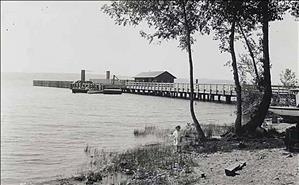On August 19, 1955, the city of Medina in King County officially incorporates. The long and winding road to incorporation includes a political footrace with the larger city of Bellevue, which is seeking to annex the community. Medina is located along the eastern shore of Lake Washington northwest of Bellevue.
Medina and the Three Points
A village nearly named Flordeline, before taking the name of an Arabian Peninsula city (but with a different pronunciation: "Me-dye-na"), started out in the 1870s and 1880s as a tiny community known for its berry farms and orchards. By the 1910s Medina had come into its own, and its charms of spacious property lots and stellar lake views began attracting attention on the Seattle side of the lake. During the next several decades a more affluent crowd settled in Medina and built large, substantial homes there.
Change came to Medina in mid-century. The entire Eastside (the Seattle metropolitan area east of Lake Washington) was growing fast. The residents of Medina and the neighboring Three Points (Evergreen, Hunts, and Yarrow points) just to the north had enjoyed county services over the years, but by the 1950s these were becoming less adequate to meet their needs. Local residents were also concerned because county zoning regulations allowed smaller lot sizes than what was the norm in the community. They feared smaller lots meant more building and more crowding. Yet they were ambivalent about doing much about it. Then, in 1953, Bellevue incorporated. Soon annexation petitions for land adjacent to the new city were flying right and left. It was obvious what was next.
Community members formed the Medina Three Points Committee, and together with Edgar Horwood (who later taught Civil Engineering and Urban Planning at the University of Washington) put together a 60-page survey on the pluses and minuses of the available options. The committee's first recommendation was to annex to neighboring Clyde Hill, located between Medina and Bellevue, which had incorporated on the same day Bellevue did. The second recommendation was to incorporate either separately or in any combination with the Three Points. Joining Bellevue was third. Still, Medina residents hesitated.
Shortly before Christmas 1954 area residents, including representatives from the Three Points, came together at a meeting of the Medina Improvement Club -- the community's heart and soul for the preceding four decades -- to discuss what to do. They voted overwhelmingly against annexing to either Clyde Hill or Bellevue. But they were divided over whether they wanted to remain part of the county or form a new city. A majority wanted to incorporate with the Three Points, but a substantial minority wanted to remain part of the county. The club decided to take another vote, this time of as many in the community as it could.
In January straw ballots went out with a simple question: "Do you favor taking steps toward incorporation with the Three Points?" ("Incorporation Opposed…"). By mid-February the vote was in. The anti-incorporation vote won by a margin of 10 percent, though the Bellevue American pointed out that the club ascertained from the ballots that the "no" vote was much stronger east of 84th Avenue NE. West of 84th, residents favored incorporation by a comfortable margin.
Now or Never
Bellevue city officials saw their chance and went for it. They scheduled a meeting with community members at the Medina Improvement Club to extol the virtues of annexation. (The club favored incorporation.) People saw it was now or never. Dueling petitions went out in the community, one favoring annexation to Bellevue, one favoring incorporation as the City of Medina. Evergreen Point was included in the incorporation petition, but not Hunts or Yarrow points, whose residents each filed separate incorporation petitions.
The incorporation forces had an advantage. The Bellevue City Council had to approve the annexation petition before annexation supporters could take it to the county and request a hearing. The Medina supporters could go straight to the county with their petition once they had enough signatures. And they did, filing during the second week of May 1955, a week before the annexation supporters even got their petition in front of Bellevue's city council. In mid-June county commissioners held a hearing on the incorporation filing and set an election date of July 26. The area sought to be incorporated was west of a line that more or less followed 84th Avenue NE from Groat Point north to the middle of Fairweather Bay.
Bellevue officials doggedly proceeded with an annexation hearing, which took place in early July. An annexation election date was duly set for August 19, contingent upon the outcome of the incorporation elections (elections in Hunts and Yarrow points also were set for July 26). The drama continued right up to Election Day. Shortly before the vote the Bellevue American editorialized against the proposed incorporation of all three communities, arguing that the creation of more local municipalities would be confusing and a waste of money. The paper suggested that a consolidated, single government could do the job better.
Incorporation
In the end, it wasn't even close. Incorporation of Medina passed by a margin of more than 25 percent, 244-135. The incorporation became official on August 19, 1955. Hunts Point residents likewise voted to incorporate, but Yarrow Point narrowly rejected incorporation. (It subsequently incorporated in 1959.)
Medina incorporated as a third-class city with an estimated population of 1,940. It operated under the council-manager system of city government, with the council electing one of its members to serve as mayor. William Park was the first mayor, and the first council members were Mary Barbee, Robert Behnke, Charles F. Dally, Carey Donsworth, William Hagen, and Frederic Templeton. One of the first things the new city officials did was tackle the zoning issue, and Medina's first zoning ordinance established spacious lot sizes of between 16,000 and 30,000 square feet.

